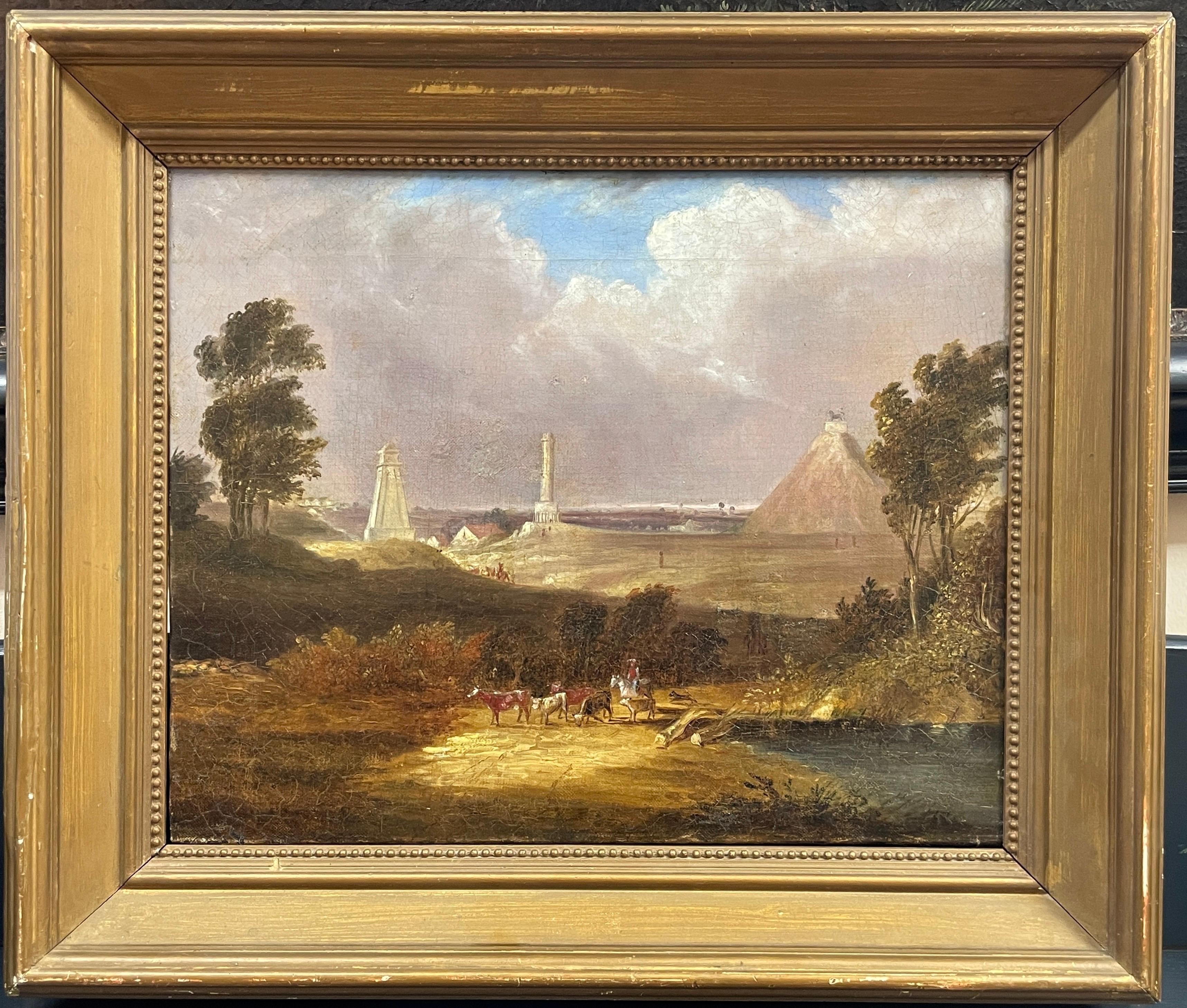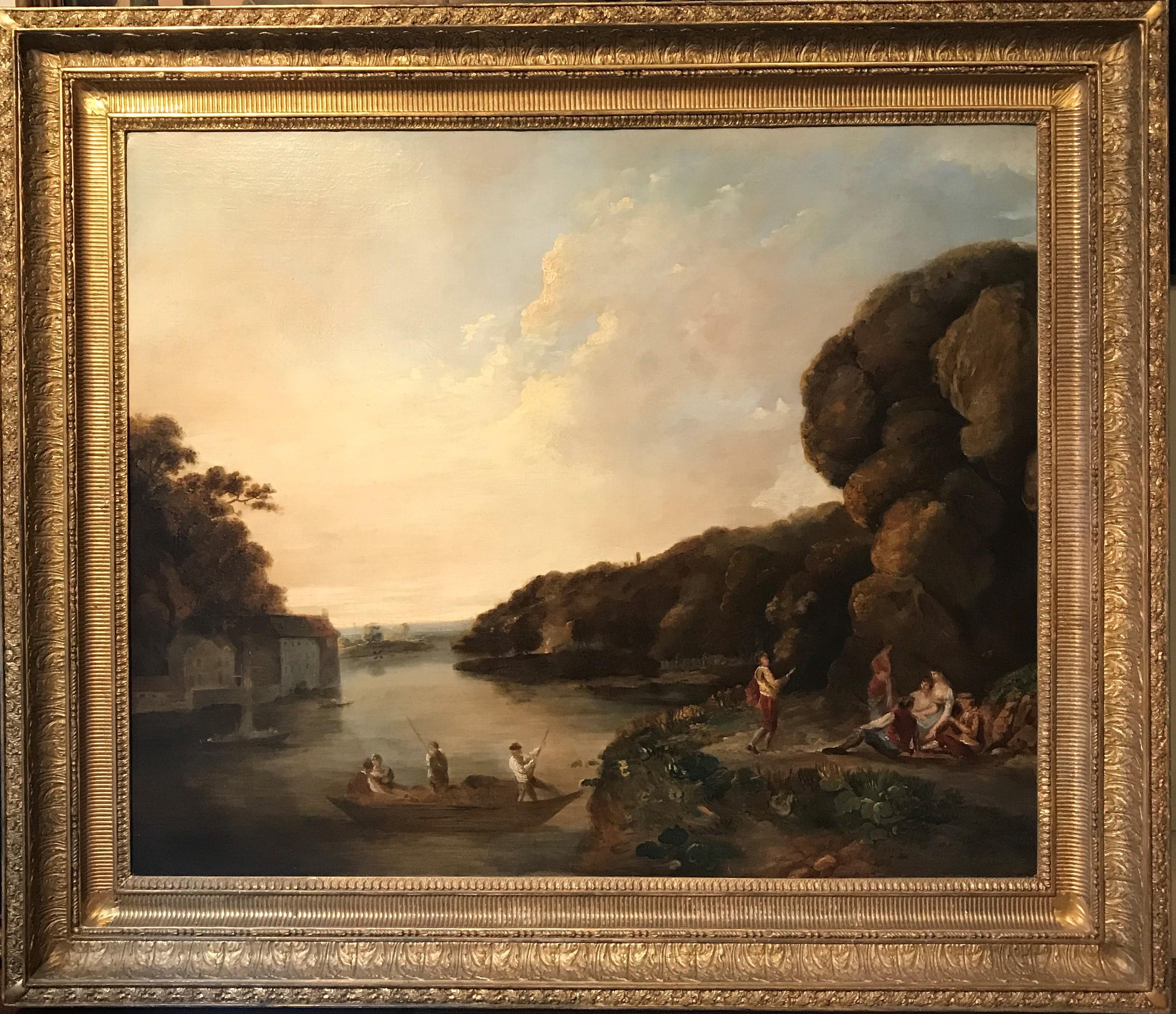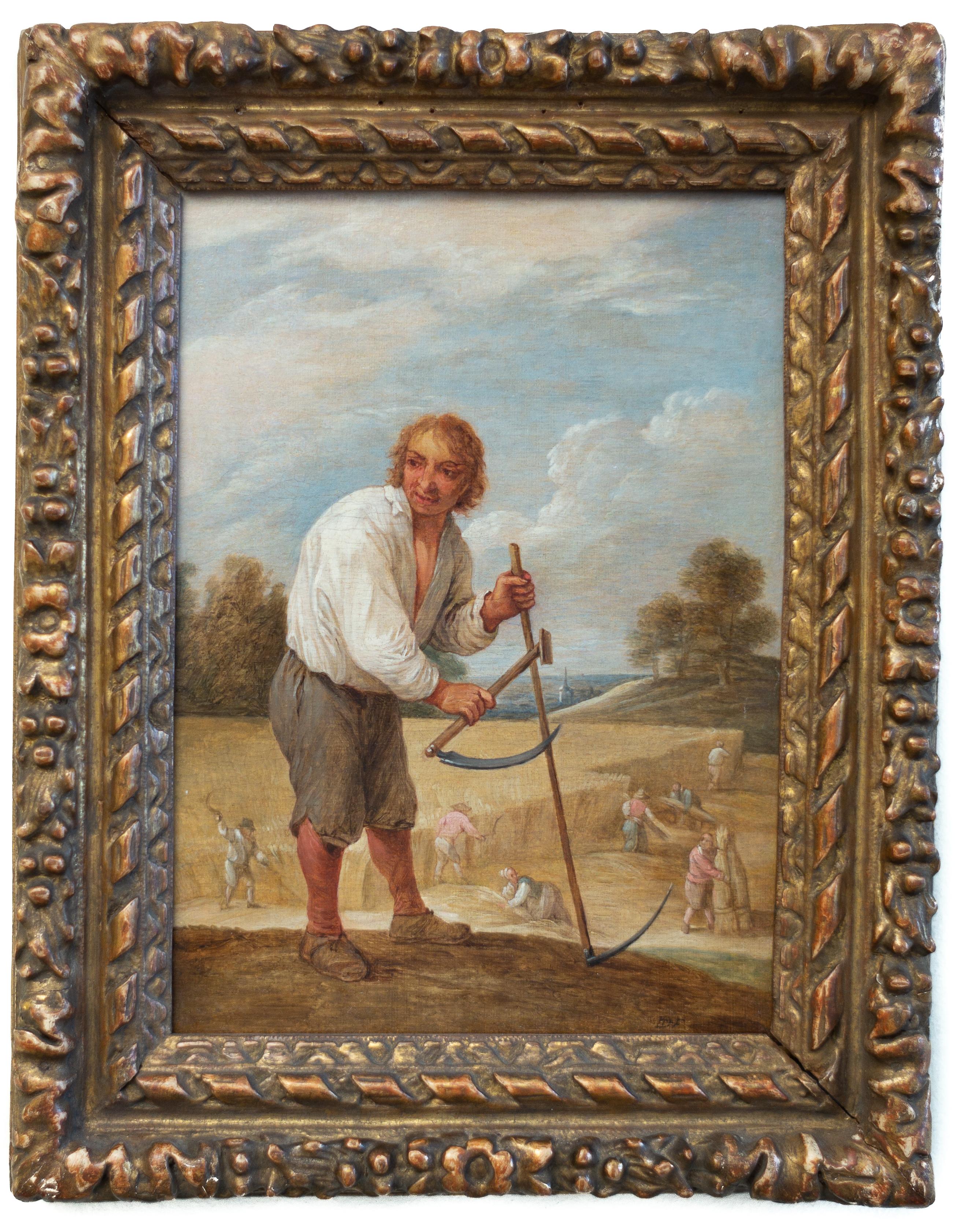Items Similar to Large 17th century religious family painting - Mary with Christ and Anna
Want more images or videos?
Request additional images or videos from the seller
1 of 16
Large 17th century religious family painting - Mary with Christ and Anna
About the Item
17th century Old Master painting depicting the Infant Christ with Mary and St. Anne attributed to Nicolas de Liemaker
The artist of the present work wonderfully captured the loving gaze of Maria, looking in awe at her child. One can sense the tenderness and love in her eyes. The eyes of Christ appears to be filled with wisdom and love and a finely painted aura crowns his and his mother's heads. St. Anne, Mary's mother, gently holds the infant whilst gazing adoringly at him. The painting is not only a beautiful depiction of Christ and his mother and grandmother, but also a sweet image of the tender bond between a mother's and their children. The vibrant and soft colours of the fabric create a soft cocoon around the figures and seem to further emphasis the beauty and importance of the depicted scenery and its protagonists.
Nicolaas de Liemaecker (also spelled as Liemaker or Liemackere) was a Flemish painter born in Ghent in 1601. He was also known under the name Nicolaas Roose. His father was Jacobus de Liemaecker, a painter upon glass. Nicolaas is reported to have been trained by his father and Gaspard de Crayer II (1), an apprenticeship with Otto Van Veen has also been suggested. In 1624 he worked at the Court of the Bishop of Paderborn and for Ferdinand of Bavaria. He later returned to his native city, where he focused on religious and historical paintings. He was a very accomplished and celebrated artist who attained a high rank in his profession. He witnessed the baptisms of Pieter and Janne-Marie Van Hulle in 1639 and 1642 (respectively) (2). He passed away in 1643.
Size of the canvas: ca. 97 by 99 cms and the total dimensions with its custom-made frame are ca. 111 by 113 cms.
Literature:
(1) De Maere, J. & Webbes, M., Martin, Jennifer A. (ed.) Illustrated dictionary of 17th century Flemish painters (3 vols.), Brussels: La Renaissance du Livre (1994)
(2) Roggen, D., Pauwels, H. & De Schryver, A., 'Het Caravaggisme te Gent', Gentse bijdragen tot de kunstgeschiedenis 12 (1949-1950), pp. 255-321
*Groenendijk, Pieter, Beknopt biografisch lexicon van Zuid- en Noord-Nederlandse schilders, graveurs, glasschilders, tapijtwevers et cetera van ca. 1350 tot ca. 1720, Leiden: Primavera (2008)
*Thieme, Ulrich & Becker, Felix, Allgemeines Lexikon der bildenden Künstler von der Antike bis zur Gegenwart, Band 23, Leipzig: Engelmann (1929)
*Turner, Jane (ed.) The dictionary of art (34 vols.), London: Macmillan; New York: Grove (1996)
Provenance:
Private collection USA
Art trade USA
- Attributed to:Nicolas de Liemaker (1601 - 1646, Flemish)
- Dimensions:Height: 38.19 in (97 cm)Width: 38.98 in (99 cm)
- Medium:
- Movement & Style:
- Period:
- Condition:Lovely and ready to hang. Inpainting visible under uv-light. Custom-made contemporary frame. Photographed with gallery-lights, benefits from a good light source to bring out its full potential.
- Gallery Location:Antwerp, BE
- Reference Number:1stDibs: LU1423213843542
About the Seller
5.0
Gold Seller
These expertly vetted sellers are highly rated and consistently exceed customer expectations.
Established in 2020
1stDibs seller since 2020
353 sales on 1stDibs
Typical response time: 4 hours
- ShippingRetrieving quote...Ships From: Antwerp, Belgium
- Return PolicyA return for this item may be initiated within 2 days of delivery.
More From This SellerView All
- 17th century Flemish Old Master painting - Countryside landscape - RubensLocated in Antwerp, BE17th century Flemish old master painting depicting a peaceful countryside scenery by Lucas Van Uden Lucas Van Uden's life unfolded against the backdrop of the rich artistic tapestry...Category
17th Century Old Masters Landscape Paintings
MaterialsOil, Canvas
- Huge 17th century old master - The feast of Bacchus - celebration PoussinLocated in Antwerp, BEHuge 17th century Old Master painting "Bacchus celebration" attributed to Niccolo de Simone The Bacchus celebration, also known as Bacchanalia, was...Category
17th Century Old Masters Figurative Paintings
MaterialsCanvas, Oil
- 17th century Flemish Italian Old Master - The baptism of Christ - ReligiousLocated in Antwerp, BE17th century Flemish old Master painting The present painting is truly a little jewel with its vibrant colours and skilful brushwork. It depicts the Baptism of Christ, a depiction of a tale filled with hope and positivity, it is a very fine example of Malo's talent. We would like to thank Anna Orlando for her assistance in cataloguing this painting. A copy of her entry on this painting will be given to the buyer. She writes about the present painting: The painting illustrated here, unpublished, refers to Vincenzo (Vincent) Malò, a Flemish artist active in Italy and in particular in Genoa in the first half of the seventeenth century, by now well known. The critics who started studying him in the sixties of the last century recognized the initial confusion of our painter with Vincenzo Alemanno (1595-1675); many documents subsequently traced both in the Genoese and Roman archives have partially specified his biographical details, but certainly his identity. Son of a certain Nicola, Vincent trained in Antwerp with David Teniers the Elder and then with Rubens, he was intermittently enrolled in the painters' guild, between 1623 and 1634. It is unlikely that he first arrived in Genoa in 1625 , when the city was at war against the Savoys, and it is entirely probable that his stay in Italy fell between 1634 and the year of his death, documented in Rome in 1644. It were about ten fertile years, also thanks to the lessons from Rubens who had taught him to paint speedily...Category
17th Century Old Masters Figurative Paintings
MaterialsCanvas, Oil
- Large 17th century Italian old master - Noli me tangere - Christ in the gardenBy Pier Francesco CittadiniLocated in Antwerp, BELarge 17th century Italian old master - Noli me tangere - Christ in the garden with Mary Magdalene The Italian art historian Federico Zeri has conserved a painting in his archives w...Category
17th Century Old Masters Figurative Paintings
MaterialsCanvas, Oil
- 17th century Flemish Old Master painting - Vast landscape with a majestic oakLocated in Antwerp, BE17th century Flemish old master painting depicting a forest landscape with a majestic oak Alexander Keirincx, born around 1600 in Antwerp, Belgium, was a prominent Flemish landscape...Category
17th Century Old Masters Landscape Paintings
MaterialsOil, Panel
- 17th century Dutch seascape - Stormy sea with a Dutch Hoy - Marine BoatsLocated in Antwerp, BE17th century Dutch old master oil seascape, Stormy sea with boats including a Dutch Hoy and a Packet-Boat The present painting is a peaceful, yet very lively, seascape and a beautif...Category
17th Century Old Masters Landscape Paintings
MaterialsOil, Panel
You May Also Like
- 17th Century by Simone Cantarini Adoration of The Magi Painting Oil on CanvasLocated in Milano, LombardiaSimone Cantarini (Pesaro 1612 - Verona 1648) Adoration of the Magi Oil on paper applied to canvas, cm. 16,5 x 24 – with frame cm. 22 x 29 Antique sh...Category
Early 17th Century Old Masters Figurative Paintings
MaterialsCanvas, Cotton Canvas, Oil
- Waterloo Battlefield with 3 Monuments - Butte du Lion, Antique Oil PaintingLocated in Cirencester, GloucestershireThe Battlefield of Waterloo English School, 19th century original oil painting on canvas, framed canvas: 12 x 15.5 inches framed: 17.5 x 20.5 inches condition: overall very good and presentable, some former restoration and signs of retouching visible. provenance: from a private collection A very rare and historically important early painting, depicting the Waterloo battle...Category
Early 19th Century Old Masters Landscape Paintings
MaterialsOil, Canvas
- The Parade of Swiss Guards a painting on canvas by Gabriel de Saint-AubinLocated in PARIS, FRIn this painting, Gabriel de Saint-Aubin, the great chronicler of the reign of Louis XV, takes us to the annual parade of the Swiss Guards at the Plaine de...Category
1760s Old Masters Figurative Paintings
MaterialsCanvas, Oil
- 18th Century English Oil Landscape Painting: Elegant Figures alongside River WyeBy Attributed to William MarlowLocated in London, GBAttributed to William Marlow (English, 1740-1813) Elegant Figures alongside the River Wye 1790 131 x 152 cm, inc. frame This quiet bucolic scene shows figur...Category
Late 18th Century Old Masters Figurative Paintings
MaterialsCanvas, Oil
- Peasants in a Cornfield (Boer in het veld) by David Teniers the YoungerBy David Teniers the YoungerLocated in Stockholm, SERemembering the magic of everyday life moments in the art of David Teniers: The art of David Teniers the Younger (1610–1690) coincided with the heyday of the Flemish Baroque and captured a great variety of motifs of his time. In this painting of a seemingly simple peasant scene lies keys to understanding both the imaginative mind of Teniers as well as why this time period produced some of the most iconic works in all of art history. As indicated by the name, Teniers was more or less born into his profession. As the son of David Teniers the elder, himself a painter who studied under Rubens, the younger David received training in art from a very young age and had no less than three brothers who also became painters. Because of his father’s frequent financial failures that even at times saw him imprisoned, David the younger helped to rescue the family from ruin through painting copies of old masters. Essentially, the young Teniers was confronted with painting as both a passion and creative expression as well as a necessity during difficult times, an experience that would shape much of his capacity and sensitivity in his coming life. Despite the hardships, the talent and determination of Teniers was recognized and quickly expanded his possibilities. He had already spent time in France and possibly also England when he was hired by his father’s former teacher Rubens to help with a prestigious commission with mythological paintings, now considered lost, for Philip IV the king Spain. In 1644–54 Teniers was appointed dean of the Antwerp Guild of Saint Luke, manifesting his esteemed position within the artistic community. A few years afterwards he took an important step when relocating to Brussels, where Teniers yet again found new career opportunities that would prove to be very successful. As the keeper of the collections of Archduke Leopold Wilhelm, a role similar to what we now refer to as an art advisor, Teniers purchased hundreds of important artworks that manifested the prominent status of the Archduke’s collection while at the same time providing an unusual access to inspiration and knowledge for Teniers himself. Since he kept on painting during the same time, his creative scope must have seemed almost bewildering in the great variety of images and stories that he surrounded himself with. Regardless of how glamorous and culturally stimulating the career of Teniers was, he was as open to the charm and existential importance of everyday life as he was to works of great masters and luxurious collectibles. In his impressive repertoire of genres with everything from exquisite royal portraits, interiors, landscapes and history paintings he always added something new and inventive, highlighting the possibilities of art and importance of an experimental and intuitive mind. It is difficult to single out one aspect or genre to summarize his legacy, since it lies much more in the broad virtuosity across many motifs, although he is particularly remembered for farm scenes and meticulously depicted interiors where other paintings and artworks are captured with an astonishing precision. However, the fact that he is still today one of the most known and celebrated names of the Dutch Golden Age is a proof to the magic of his work, which continues to spark dialogue and wonder in the contemporary viewer of his works. The farm boy in the field in this painting, which likely dates to the mature part of his career, is a wonderful entry into the mind of Teniers. In the tightly cropped motif, we see him standing right in the middle of the busy harvest when men, women and everyone capable were sent out in the field to collect the crop that formed the very core of their diet and survival. In the background we see a fresh blue sky interspersed with skillfully painted clouds, some trees reaching their autumnal colours and in the far distance the glimpse of a small church and village. The presence of a church in a landscape, so typical of Dutch art, served both a symbolic and visual function as a representation of faith while at the same time defining scale and distance. In the field, the work is in full action with the farmers spread out in various positions, all in the midst of hard and sweaty labour. While they are portrayed as having nothing else than the work on their mind, our farm boy seems to have his attention directed elsewhere. Standing there with his white, half open shirt, flowy curls and strong, sturdy body; his gaze is directed away, out of the picture and the scythes in his hands. He looks almost smirking, expressed with tremendous subtlety in the slight smile of his lips and big eyes, being just in the middle of losing focus on the work. What is it that steals his attention? What has he seen, or realized, or felt – to break him free of the arduous task of harvesting, if but for a moment? Here starts the wondering and the questions that are the hallmark of a great piece of art. Instead of explicitly locking in the motif in overly clear symbolism Teniers has chosen an open ended, subtle yet striking moment for us to consider. While it of course can be related to numerous other farm scene depictions of this time, and clever usages of gazes and real-life scenes to underscore various moral or symbolic meanings, the painting can be much more of a contemplation than an explanation or illustration. The ordinary nature and understated yet emotionally textured composition of the motif gives greater space for our own reactions and thoughts. Has he seen a pretty farm girl just passing by? Is he fed up with the farm life, joyously dreaming away for a minute, imagining another future? Or is he simply in need of distraction, looking away and ready for anything that can steal his attention? One quality that never seem to have escaped Teniers was that of curiosity. During all of his career he constantly investigated, expanded and experimented with not only the style and technique of painting, but with the vision of art itself. Being credited with more or less introducing farm motifs for a broader audience not only tells us of his ability to understand the demand for different motifs, but the sensitivity to transform seemingly ordinary parts of life into deep aesthetic experiences, far beyond their expected reach. The farm boy in this painting is, of course, exactly that. But with the help of one smirk the entire picture is charged with a different energy, awakening many contrasts and relationships between the calm landscape, the hard work and his own breach of effectivity, holding sharp scythes while thinking or seeing something else. It is no wonder Teniers chose to work with farm scenes as a way of investigating these intricate and delicate plays on expectations and surprises, clarity and ambivalence. It invites us to an appreciation of human everyday life that connects us with the people of 17th century...Category
Late 17th Century Old Masters Landscape Paintings
MaterialsOil, Canvas
- Large 18th Century English Old Master Oil Painting Portrait of Lady on canvasLocated in Cirencester, GloucestershirePortrait of a Lady English School, 18th century oil on canvas, unframed canvas : 31 x 25 inches provenance: private collection, UK condition: good and sound conditionCategory
Early 18th Century Old Masters Landscape Paintings
MaterialsOil, Canvas
Recently Viewed
View AllMore Ways To Browse
Antique Painting Framed Large
Old Antique Religious Art
Framed Religious Painting
De Vol
17th Century Old Master
Flemish Painters
De Nicola
Antique Religious Painting Paintings
Anna New York
Train Children
Antique Dictionary
Mary With Child
Antique Religious Oil Painting Paintings
Mary Ii
17th Century Fabric
17th Century Flemish Painting
H Mary Oil Painting
Old Master Paintings Of Children





